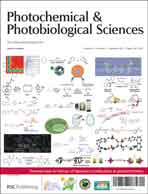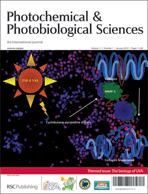
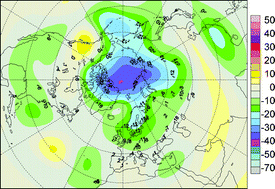
Read 2012 Issue 1 online here!


Read 2012 Issue 1 online here!
Hydrophilic photolabile protecting groups (PPGs) for hydroxyl protection have been developed by Pengfei Wang and co-workers from the University of Alabama at Birmingham.
PPGs are protecting groups that can be removed with photo irradiation, they very useful tools in a range of basic and applied research areas. One of these applications is their use as ‘photocages’ where the photochemical removal of the photogages often takes place in aqueous environments meaning that solubility issues are central to the use of caged biomolecules.
This team have previously developed a novel PPG for hydroxyl groups, 3-(dimethylamino)trityl (DMATr) but its hydrophobicity obstructs its wide applications in aqueous environments so in their recently published PPS article they report their efforts to improve its water solubility. The new PPGs the team developed were derived from DMATr by replacing the two methyl groups with two hydrophilic butyryl groups. The new PPG reagents can be readily prepared and installed. They are stable in the dark but can be removed cleanly and efficiently in aqueous environments upon irradiation with a UV lamp or sunlight.
This paper is part of a themed issue on photoremovable protecting groups due to be published in 2012.
Interested in knowing more? Read the full article for free until 20th December 2011
Development of hydrophilic photolabile hydroxyl protecting groups
Haishen Yang, Lei Zhou and Pengfei Wang
Photochem. Photobiol. Sci., 2012, DOI: 10.1039/C1PP05281K
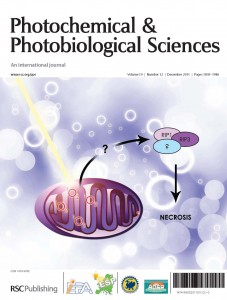 PPS issue 12 is now online. The last issue of 2011 features work on the front cover from Jacques Piette and co-workers from the University of Liège and the Catholic University of Leuven in Belgium.
PPS issue 12 is now online. The last issue of 2011 features work on the front cover from Jacques Piette and co-workers from the University of Liège and the Catholic University of Leuven in Belgium.
Their article ‘5-ALA-PDT induces RIP3-dependent necrosis in glioblastoma’ which was featured on the PPS blog earlier this month gives new insights in to the mechanism of action of 5-aminolevulinic acid (5-ALA) based photodynamic therapy (PDT) against glioblastoma revealing the involvement of receptor-interacting protein 3 (RIP3) in necrosis induction. Read more about it here, the full article is free to access until 6th January 2012!
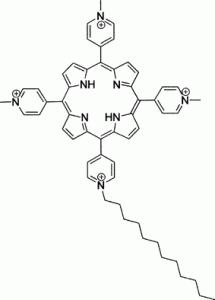 The effects a new photoactivatable cationic prophyrin on components of freshwater ecosystems polluted by pathogenic agents responsible for malaria is investigated in a recent article from teams based at the University of Padova and the university of Camerino in Italy and Institut de Recherche en Science de la Santé in Burkina Faso. This paper is part of a research project which is aimed at the prevention of water- and vector-borne diseases such as Anopheles and Aedes larvae through adequate control of porphyrin-photosensitised processes. These larvae are responsible for the worldwide diffusion of serious diseases, such as malaria and Dengue fever.
The effects a new photoactivatable cationic prophyrin on components of freshwater ecosystems polluted by pathogenic agents responsible for malaria is investigated in a recent article from teams based at the University of Padova and the university of Camerino in Italy and Institut de Recherche en Science de la Santé in Burkina Faso. This paper is part of a research project which is aimed at the prevention of water- and vector-borne diseases such as Anopheles and Aedes larvae through adequate control of porphyrin-photosensitised processes. These larvae are responsible for the worldwide diffusion of serious diseases, such as malaria and Dengue fever.
Porphyrins are characterized by a macrocyclic molecule which absorbs visible light and transfers some of this absorbed energy to molecular oxygen forming reactive oxygen species (ROS). Porphyrins and visible light are, individually, devoid of any bio-toxicity but when ROS are formed in a cell they are cytotoxic and cause irreversible cell death. Their toxicity is the result of a multi-target mechanism involving parallel damage of a large number of cell constituents thus allowing very little opportunity for the selection of photoresistant microbial strains or the onset of mutagenic processes. These photo processes show a high selectivity in space and time and are especially suitable to address problems connected with environmental pollution caused by the presence of large populations of potentially pathogenic microorganisms.
In collaboration with the company Frontier Scientific (Logan, Utah) the team from Italy and Burkina Faso have developed a specific porphyrin, named AquaFrin. Studies by the teams in Italy demonstrated that AquaFrin, once mixed with standard larval food, is rapidly ingested by Anopheles and Aedes larvae and localises in their alimentary canal. This makes the larvae photosensitive and the exposure of the porphyrin-loaded larvae to low intensity visible light induces an efficient death. The successful extension of the technique to breeding sites of Anopheles larvae under natural conditions depends on the fulfilment of specific requirements:
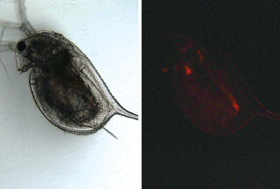 It is this final issue that the recently published PPS article concerns. The article investigates the effects of the porphyrin on ciliated protozoa and branchiopod crustaceans which are components of the freshwater ecosystems that Anopheles larvae pollute. These organisms are sensitive to the porphyrin but killing doses are an order of magnitude larger than those which are phototoxic to larvae.
It is this final issue that the recently published PPS article concerns. The article investigates the effects of the porphyrin on ciliated protozoa and branchiopod crustaceans which are components of the freshwater ecosystems that Anopheles larvae pollute. These organisms are sensitive to the porphyrin but killing doses are an order of magnitude larger than those which are phototoxic to larvae.
Field studies have been performed in Burkina Faso and have given very positive results. Pollen – or cat food-bound AquaFrin were added to endemic breeding sites of Anopeles larvae and when illuminated by daylight an extensive mortality was observed to occur within a few hours.
At present, the investigations are being extended to a number of areas in sub – Saharan countries, in order to validate and possibly refine the larvicidal protocol tailoring it to situations characterized by different species of Anopheles larvae, as well as different physical and chemical or optical quality of water, climatic conditions, biological composition of the ecosystem.
Interested in knowing more? Read the full article for free until December 7th.
Effects of a new photoactivatable cationic porphyrin on ciliated protozoa and branchiopod crustaceans, potential components of freshwater ecosystems polluted by pathogenic agents and their vectors
Clara Fabris, Marina Soncin, Giulio Jori, Annette Habluetzel, Leonardo Lucantoni, Simon Sawadogo, Laura Guidolin and Olimpia Coppellotti
Photochem. Photobiol. Sci., 2012, DOI: 10.1039/C1PP05154G
 PPS issue 11 is now online. It features work on the front cover from Ana Flavia Nogueira and colleagues from the University of Campinas and the Physics Institute of São Carlos in Brazil. In their article they describe the preparation of multilayer films based on poly(p-phenylenevinylene) (PPV) and carboxylic-functionalized single-walled carbon nanotubes (SWNT-COOH) by electrostatic interaction using the layer-by-layer deposition method. The thin films show considerable photocurrent responses, making them promising candidates as active layers for organic photovoltaic cells.
PPS issue 11 is now online. It features work on the front cover from Ana Flavia Nogueira and colleagues from the University of Campinas and the Physics Institute of São Carlos in Brazil. In their article they describe the preparation of multilayer films based on poly(p-phenylenevinylene) (PPV) and carboxylic-functionalized single-walled carbon nanotubes (SWNT-COOH) by electrostatic interaction using the layer-by-layer deposition method. The thin films show considerable photocurrent responses, making them promising candidates as active layers for organic photovoltaic cells.
Read this article for free until 15th December:
Photoelectrochemical, photophysical and morphological studies of electrostatic layer-by-layer thin films based on poly(p-phenylenevinylene) and single-walled carbon nanotubes
L. C. P. Almeida, V. Zucolotto, R. A. Domingues, T. D. Z. Atvars and A. F. Nogueira
Photochem. Photobiol. Sci., 2011, 10, 1766-1772
Read PPS issue 11 online here.
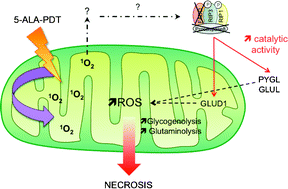 New insights in to the mechanism of action of 5-aminolevulinic acid (5-ALA) based photodynamic therapy (PDT) against glioblastoma reveal the involvement of receptor-interacting protein 3 (RIP3) in necrosis induction.
New insights in to the mechanism of action of 5-aminolevulinic acid (5-ALA) based photodynamic therapy (PDT) against glioblastoma reveal the involvement of receptor-interacting protein 3 (RIP3) in necrosis induction.
Glioblastoma are one of the most frequent and deadly brain tumours in human adults; prognosis with this type of cancer is very poor but 5-ALA-PDT has been emerging as a promising treatment. In this treatment 5-ALA is metabolized into the protoporphyrin IX (PPIX) photosensitizer inside mitochondria and PPIX preferentially accumulates into cancer cells due to their ferrochelatase deficiency.
This study from Jacques Piette and co-workers in Belgium is a result of the observation that 5-ALA-PDT treatment of glioblastoma leads to cell death by necrosis rather than apoptosis. It has become clear that cell death from necrosis is actually a programmed event rather than the accidental cell death it was long thought to be; this has coined the term necroptosis. Recent studies into the mechanism of necroptosis have revealed that a key effector is RIP3, a Ser/Thr kinase belonging to the RIP kinase family.
Jacques Piette and co-workers show that 5-ALA-PDT-induced necrosis in glioblastoma cells was dependent on RIP3 and that PDT-mediated singlet oxygen production is the cause of the RIP3-dependent necrotic pathway activation.
Further details are presented in their recently published Photochemical and Photobiological Sciences article which is free to access until 30th of November.
5-ALA-PDT induces RIP3-dependent necrosis in glioblastoma
Isabelle Coupienne, Grégory Fettweis, Noemí Rubio, Patrizia Agostinis and Jacques Piette
Photochem. Photobiol. Sci., 2011, DOI: 10.1039/C1PP05213F
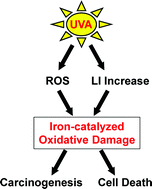 A recently published perspective from Charareh Pourzand, Rex Tyrrell, co-editor-in-chief of PPS, and co-workers at the University of Bath gives an overview of recent findings on intracellular labile iron (LI) distribution and trafficking. Using UVA radiation as an example, it also discusses mechanisms and consequences of oxidant-induced alterations in the intracellular pool of LI. This perspective forms part of an upcoming themed issue on UVA.
A recently published perspective from Charareh Pourzand, Rex Tyrrell, co-editor-in-chief of PPS, and co-workers at the University of Bath gives an overview of recent findings on intracellular labile iron (LI) distribution and trafficking. Using UVA radiation as an example, it also discusses mechanisms and consequences of oxidant-induced alterations in the intracellular pool of LI. This perspective forms part of an upcoming themed issue on UVA.
Iron is a vital nutrient and is required for a wide variety of cellular processes due to its facile redox chemistry and affinity to oxygen. However, when the redox-active chelatable ‘labile’ form exceeds the normal binding capacity of the cell this labile iron (LI) can become toxic. In the presence of reactive oxygen species LI can catalyse the formation of oxygen-derived free radicals that overwhelm the cell’s antioxidant defence mechanism and result in cell damage. Although intracellular iron homeostasis is tightly regulated acute exposure of skin cells to UVA induces an increase in intracellular LI and this appears to play a key role in the increased susceptibility of skin cells to UVA-mediated oxidative membrane damage and necrotic cell death.
To find out more follow the link below. Full text is FREE until November 11th.
Iron, oxidative stress and the example of solar ultraviolet A radiation
Asma Aroun, Julia Li Zhong, Rex M. Tyrrell and Charareh Pourzand
Photochem. Photobiol. Sci., 2012, DOI: 10.1039/C1PP05204G
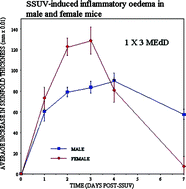 New insights into mechanisms behind gender differences in skin cancer development are revealed in this article from Vivienne Reeve and co-workers from Sydney, Australia. A contributing factor for skin cancer development in mice and humans is immunosuppression as a result of UVB light; whilst the contribution of UVA is controversial it has been shown to antagonise immunosuppression by UVB. One of the mechanisms for this UVA protection which has been demonstrated in mice is mediated via oestrogen receptor-β signalling, suggesting a gender bias in photoimmune response to UVA.
New insights into mechanisms behind gender differences in skin cancer development are revealed in this article from Vivienne Reeve and co-workers from Sydney, Australia. A contributing factor for skin cancer development in mice and humans is immunosuppression as a result of UVB light; whilst the contribution of UVA is controversial it has been shown to antagonise immunosuppression by UVB. One of the mechanisms for this UVA protection which has been demonstrated in mice is mediated via oestrogen receptor-β signalling, suggesting a gender bias in photoimmune response to UVA.
Gender bias is tested in this study by comparing the UV-induced inflammatory and immune responses in male and female hairless mice. The study uses solar simulated radiation (SSUV) to induce sunburn, the resulting inflammatory oedema is measured through the increase in irradiated skinfold thickness and levels of the pro-inflammatory cytokine interleukin (IL)-6 in the epidermis. Immune function was assessed by the contact hypersensitivity (CHS) reaction and its suppression by SSUV was related to the level of expression of the immunosuppressive cytokine IL-10 in the epidermis.
Results showed that although male mice had less intense sunburn with lower expression of IL-6 the CHS reaction was more severely suppressed by SSUV than females and this also correlated with increased epidermal expression of immunosuppressive IL-10. Exposure to UVB alone had equal effects in male and female mice, however, UVA irradiation induced immunoprotection in females but this effect was reduced or not present in males. The results indicate that males have a relative unresponsiveness to the photoimmune protective effects of UVA. This could explain the known gender bias in skin cancer development in both mice and humans.
Interested in knowing more? Read the full article here. Free until 4th November.
Gender differences in UV-induced inflammation and immunosuppression in mice reveal male unresponsiveness to UVA radiation
Vivienne E. Reeve, Munif Allanson, Diane Domanski and Nicole Painter
Photochem. Photobiol. Sci., 2011, DOI: 10.1039/C1PP05224A
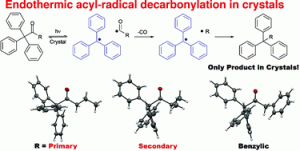 In this recently published communication John R. Scheffer and Miguel A. Garcia-Garibay and their teams from the University of British Columbia and the University of California Los Angeles demonstrate that the solid state photoexcitation of several triphenylmethylalkyl ketones results in the loss of CO and the exclusive formation of radical–radical combination products. Furthermore, differences in reactivity suggest a stepwise mechanism with the unprecedented formation of primary and secondary radicals in some of the radical pair intermediates in the solid state.
In this recently published communication John R. Scheffer and Miguel A. Garcia-Garibay and their teams from the University of British Columbia and the University of California Los Angeles demonstrate that the solid state photoexcitation of several triphenylmethylalkyl ketones results in the loss of CO and the exclusive formation of radical–radical combination products. Furthermore, differences in reactivity suggest a stepwise mechanism with the unprecedented formation of primary and secondary radicals in some of the radical pair intermediates in the solid state.
Interested in knowing more? Read the full article here. Free until October 21st!
Stable radicals during photodecarbonylations of trityl-alkyl ketones enable solid state reactions through primary and secondary radical centers
Gregory Kuzmanich, Arunkumar Natarajan, Yanhui Shi, Brian O. Patrick, John R. Scheffer and Miguel A. Garcia-Garibay
Photochem. Photobiol. Sci., 2011, DOI: 10.1039/C1PP05240C
PPS Issue 9 is a themed issue in honour of the contribution of Japanese scientists to photochemistry, read Guest Editors’ Cornelia Bohne (University of Victoria, Canada) and Tadashi Mori (Osaka University, Japan) Editorial here. The front cover features a selection of images from the articles included in this themed issue.
